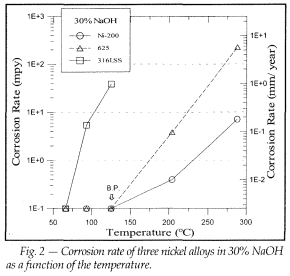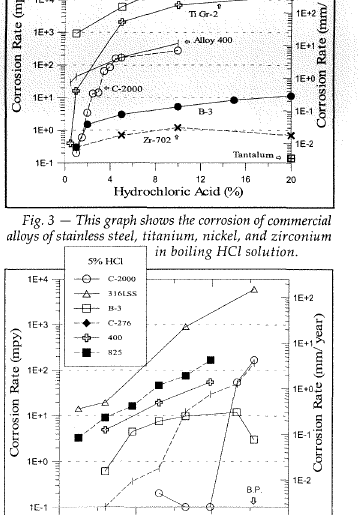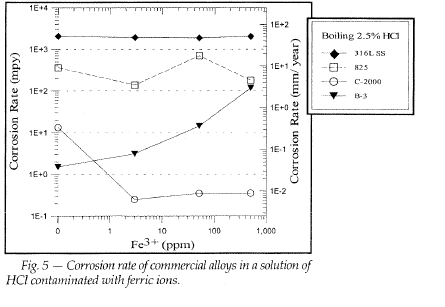Nickel Alloys for Corrosive Environments
A wide range of nickel-base alloys is available for applications in highly aggressive environments.
Nickel-base alloys provide outstanding resistance to specific chemicals, and some are extremely versatile and able to handle complex process and waste streams. In particular, the versatile alloys are much less subject than stainless steels to stress corrosion cracking, pitting, and crevice attack in hot chloride-bearing solutions. Also, nickel alloys are among the few materials able to withstand hot hydrofluoric acid, a chemical that is very corrosive to the reactive metals (titanium, zirconium, niobium, and tantalum).
The aim of this article is to describe the general characteristics of nickel-base alloys and to examine the effects of different aggressive environments on the corrosion behavior of these alloys.
Nickel alloy types
The nickel alloys can be categorized according to the main alloying elements, as follows:
- Nickel: primarily for caustic solutions.
- Nickel-copper: primarily for mild, reducing solutions, especially hydrofluoric acid.
- Nickel-molybdenum: primarily for strong, reducing media.
- Nickel-iron-chromium: primarily for oxidizing solutions.
- Nickel-chromium-silicon: primarily for super-oxidizing media.
- Nickel-chromium-molybdenum: versatile alloys for all environments.
The terms “reducing” and “oxidizing” refer to the nature of the reaction at cathodic sites during corrosion. Reducing solutions such as hydrochloric acid generally induce hydrogen evolution at cathodic sites. Oxidizing solutions such as nitric acid induce cathodic reactions with higher potentials.
Copper, molybdenum, and tungsten all increase the inherent corrosion resistance of nickel. In addition, molybdenum and tungsten are significant strengthening agents, due to their large atomic sizes. The compositions of a few nickel alloys are given in Table 1. These are all wrought alloys, available in the form of plates, sheets, bars, pipes, tubes, forgings, and wires.
The role of chromium is the same as that in the stainless steels: it enhances the formation of passive surface films, in the presence of oxygen. These passive films impede the corrosion process. Iron, if added to the nickel alloys, also affects passivation. Silicon is beneficial at high corrosion potentials, where chromium-rich passive films cannot be maintained. It offers extended protection through the formation of protective (silicon-rich) oxides.
Nickel alloy metallurgy
Second phases are possible, if they are subjected to elevated temperature excursions, for example during welding. The kinetics of second-phase formation depend critically on the amount of over-alloying and the content of minor elements, such as carbon and silicon. Carbon is kept as low as possible in the wrought alloys by special melting techniques. Silicon is also held at low levels in most of the wrought alloys, since it is a strong promoter of second phases. Indeed, this is why the Ni-Cr-Si materials are not more highly alloyed. In cast nickel alloys, a small quantity of silicon is necessary for fluidity during pouring. However, it heightens the importance of the solution annealing and quenching processes with castings.
Nickel alloy performance
Although the number of environments encountered within the chemical process industries is vast, the performance of metallic materials is most often based on their resistance to a few aggressive inorganic chemicals. These are predominantly hydrochloric acid, sulfuric acid, and hydrofluoric acid. Also very important are the effects of residuals such as ferric ions.
Caustic solutions: The most common caustic solutions are sodium hydroxide or caustic soda (NaOH) and potassium hydroxide or caustic potash (KOH). When contamination with iron or stress corrosion cracking is not a problem, these substances are sometimes handled in carbon steel; however, nickel and nickel alloys are the metals that offer the highest resistance to corrosion in caustic solutions. Figure 1 shows the corrosion rate of several alloys in boiling 50% NaOH solution. The higher the nickel content in the alloy, the lower the corrosion rate. The corrosion resistance of nickel is a consequence of the formation of insoluble metal hydroxides and salts, which slow down the dissolution rate of the alloy.
Figure 2 shows the corrosion rate of three alloys in 30% NaOH as a function of the temperature. Ni-200 offers the best resistance to corrosion, especially at the higher temperatures.
Sodium hypochlorite (bleach) can be considered a mildly oxidizing alkaline salt that can also be successfully handled by a nickel alloy, especially of the Ni-Cr-Mo group (C-276 or C-2000® alloys).
Hydrochloric acid: Hydrochloric acid (HCl) is very corrosive, and its aggressiveness can change drastically depending on the acid concentration, temperature, and contamination of the acid (e.g. ferric ions). In general, steels, stainless steels, and copper alloys cannot tolerate HCI. Of the reactive metals, titanium does not resist HCl well, zirconium is satisfactory for pure acid, and tantalum offers excellent performance. Figure 3 shows the corrosion behavior of several alloys in boiling solutions of pure hydrochloric acid. At intermediate acid concentrations, the corrosion rate of 316 SS can be more than four orders of magnitude higher than the corrosion rate of zirconium or B-3® alloy.
Figure 4 shows the effect of temperature on the corrosion rate of several nickel-base alloys and 316L SS. For most of the alloys, the corrosion rate gradually increases as the temperature increases.
For C-2000® alloy, a threshold temperature is reached, below which the corrosion rate is negligible due to passivation of the alloy; above the threshold temperature, the corrosion rate increases rapidly as the temperature increases.
However, for the B-3® alloy, the corrosion rate does not depend strongly on temperature. The fact that the corrosion rate of the B-3® alloy at the boiling temperature is lower than the corrosion rate at temperatures below the boiling point, could be related to the amount of dissolved oxygen at each temperature (which decreases as the temperature increases).
The nickel alloys that should be considered for service in pure hydrochloric acid are shown in Table 2, a nine-segment chart organized by concentration and temperature. The selections are based on evidence that alloys from the chosen groups exhibit rates of 0.5 mm/y (20 mpy) or less over significant concentration and temperature ranges, within those segments. Table 2 covers only concentrations up to 20 wt%, the maximum that can be sustained in a boiling solution. It indicates that, of the nickel alloys, only those from the nickel-molybdenum group are suitable at high concentrations and temperatures.
In fact, molybdenum is the most important alloying element for good performance of nickel-base alloys in pure hydrochloric acid (reducing conditions). The corrosion rate in boiling HO decreases as the content of molybdenum in the alloy increases.
Oxidizing impurities in hydrochloric acid, such as ferric ions (Fe3+), are detrimental to the performance of the nickel-molybdenum and nickel-copper alloys. Under such conditions, the nickel-chromium molybdenum alloys constitute the best choice, because they are tolerant of residuals, although they are temperature-limited at the higher acid concentrations.
Figure 5 shows the corrosion rate of several alloys in boiling 2.5% HCl solution as a function of the concentration of ferric ions in the solution. The corrosion rates of 316L SS and alloy 825 are high, and are not affected significantly by the presence of ferric ions. The corrosion rate of the B-3® alloy in the pure boiling acid is low, but it gradually increases as the content of ferric ions in the solution increases. The corrosion rate of C-2000® in pure acid is higher than that of the B-3® alloy; however, a content of only 3 ppm Fe3+ produces a decline in its corrosion rate by almost two orders of magnitude. The oxidizing ferric ions promote the passivation of C-2000® by the formation of a chromium-rich oxide film that reduces the uniform dissolution rate.
Figures 3, 4, and 5 show that the nickel-chromium-molybdenum alloys such as C-2000® are resistant to HO in a moderately broad range of concentrations and temperatures, whereas 316L stainless steel is generally unsuitable for hydrochloric acid service. Alloys 400 and 825 may be adequate at room temperature.
Titanium Grade 2, as well as the stainless steels containing 6% molybdenum (such as 254SMO), are resistant to low concentrations of HCl. The resistance of zirconium (Zr-702 alloy) to pure hydrochloric acid is exceptional; however, in the presence of ferric ions Zr-702 would be subjected to pitting corrosion. Tantalum also exhibits excellent resistance to pure HO solutions up to 175°C (350°F), but it is unacceptable if the HO solution is contaminated with fluorides. Fluoride ion impurities are also damaging to titanium and zirconium alloys.
Sulfuric acid: Sulfuric acid is the most widely used acid in all branches of industry. Sulfuric acid is less corrosive than hydrochloric acid, and its aggressiveness is highly dependent on acid concentration, temperature, and the presence of impurities. Figure 6 shows the corrosion rate of several alloys in boiling pure sulfuric acid. Sulfuric acid aqueous solutions up to 96 wt% are stable at the boiling point.
However, these boiling points increase dramatically at the medium and high concentrations. For example, at 20% sulfuric acid, the boiling point is 104°C (220°F), at 50% is 123°C (253°F), and at 80% is 202°C (395°F). Titanium Grade 2 and 316L stainless steel are not adequate for sulfuric acid service.
Figure 6 shows that the B-3® alloy has the lowest corrosion rate of the nickel alloys in boiling sulfuric acid. Only at the highest acid concentration (> 70%) does the corrosion rate of B-3® start to increase. The strong concentration effect on the corrosion rate of zirconium alloy 702 is also revealed.
Figure 7 shows the effect of temperature at a constant acid concentration. As in the case of HCl solutions.
(Fig. 4), the temperature has a strong influence on the corrosion rate of Ni-Cr-Mo and Ni-Cr-Mo-Fe alloys such as C-2000® and G-30®; however, the corrosion rate of aNi-Mo alloy (B-3) is almost unaffected by the temperature (low activation energy).
Table 3 shows the types of nickel alloy that should be considered for service in pure sulfuric acid, depending on the acid concentration and temperature. The selections are based on evidence that alloys from the chosen groups exhibit rates of 0.5 mm/ y (20 mpy) or less over significant concentration and temperature ranges, within those segments. The important revelations of this chart are the excellent corrosion resistance of the nickel-molybdenum alloys in pure sulfuric acid, the good resistance of the nickel-chromium-molybdenum materials, and the usefulness of several groups at lower concentrations and temperatures.
The presence of contaminants in sulfuric acid could change the corrosion rate of the alloys. Figure 8 shows the corrosion rate of alloys B-3® and C-2000® in pure sulfuric acid and in sulfuric acid contaminated with 200 ppm chloride ions (as NaCl). The corrosion rate of both alloys increases if the solution is contaminated; however, the effect seems more pronounced for the Ni-Cr-Mo alloy.
Hydrofluoric acid: Hydrofluoric acid is extremely corrosive and unique in its corrosion behavior. Many industries use it as an aqueous solution, as a fluorinating agent, for metal pickling, and in the manufacturing of semiconductors.
Nickel alloys are the only alloys that are widely chosen for handling aqueous solutions of hydrofluoric acid, because stainless steels, titanium, zirconium, and tantalum are not adequate for this application.
The most common alloy for handling aqueous hydrofluoric acid is wrought Monel 400. This alloy has excellent corrosion resistance in the absence of air or other oxidizing species; however, if oxygen is present, it is subject to accelerated inter-granular attack, especially in the vapor phase.
Figure 9 shows the corrosion rate of three nickel alloys in the liquid phase (immersed conditions), and in the vapor phase where vapor condenses on the coupons (for these tests, the ingress of air to the testing kettles was not restricted).
Alloy 400 corrodes at high rates in the vapor phase, because of inter-granular attack. The corrosion rate of alloy 400 is higher at the higher temperature, both for the liquid and vapor phases.
The corrosion rate of the B-3® alloy is lower in the vapor phase than in the liquid phase. Moreover, at the higher temperature, its corrosion rate in both phases is lower. In general, the corrosion rate of B-3® is not highly influenced by the temperature; therefore, the lower corrosion rate at the higher temperature can be the result of a lower availability of oxygen both in the liquid and vapor phases. The B-3® alloy is subject to pitting corrosion in HF environments, both in the liquid and vapor phases.
The C-2000® alloy showed the lowest corrosion rate in all the tested conditions. Laboratory testing has also shown that the corrosion rate of C-2000® in the vapor phase is time dependent; that is, the rate decreases as the test duration increases. This is probably due to the gradual development of a protective film on the surface. The corrosion rates of alloys 400 and C-2000® in the liquid phase do not depend on the testing time.
Nickel-base alloys are susceptible to stress corrosion cracking in the presence of aqueous solutions of hydrofluoric acid. Not all nickel alloys are equally susceptible to SCC under the same conditions; that is, cracking is strongly dependent on several variables, such as alloy composition, temperature, presence of oxygen, and liquid vs. vapor phase.
Mixtures of hydrofluoric and nitric acid are typical in the metal industry for pickling processes. In a solution of 20% HNO3 containing different amounts of hydrofluoric acid, the lowest corrosion rate corresponds to G-30®, a Ni-Cr-Fe alloy containing 30% chromium. The high chromium content promotes the formation of a passive film in the oxidant nitric acid, and does not seem to be readily attacked by the hydrofluoric acid.
Other acids: Phosphoric acid (H3P04) is not highly corrosive to nickel alloys. Two distinct types of phosphoric acid are encountered in the industry. The pure (reagent grade) acid is made from elemental phosphorus, derived from phosphate rock. This is oxidized, then reacted with water. On the other hand, the preferred type of phosphoric acid in the agrichemical industries is made by reacting phosphate rock with sulfuric acid. This contains several impurities, notably sulfuric acid, silica, and chloride and fluoride ions, which markedly affect the corrosion behavior of the acid. The levels of these impurities vary depending on the source of the rock, and different batches of this so-called “wet process” acid can vary considerably in their corrosively.
The G-30® alloy is generally preferred to handle the “wet process” phosphoric acid. For pure phosphoric acid, Ni-Mo (B-3®), Ni-Cr-Mo (C-276, C-2000) and Ni-Fe-Cr (G-30®) alloys can function in up to 85% acid up to the boiling point.
The corrosion behavior of hydrobromic acid (HBr) is similar to that of hydrochloric acid; however, HBr is less aggressive. Therefore, when pure and hot, HBr is best handled by a Ni-Mo alloy such as the B-3® alloy. A Ni-Cr-Mo alloy such as C-2000® is versatile and is suitable for most applications containing HBr, especially in solutions contaminated with oxidizing species.
Organic acids such as formic and acetic acids are not highly corrosive for nickel alloys. At temperatures higher than 100°C (212°F), the B-3® alloy (NiMo) would offer the lowest corrosion rate.
Nitric acid is a strong oxidizing acid which, besides zirconium and titanium alloys, can be handled with stainless steels or nickel alloys containing at least 15% chromium (other nickel alloys such as B-3®, Ni-200, and Monel400 cannot be used in nitric acid). For most purposes, a nickel alloy is not required to handle nitric acid; however, nickel alloys resist corrosion better than stainless steels in cases where the nitric acid is contaminated with chlorides.
| Table 1 Nominal Composition of Nickel alloys | |||||||
| Group | Alloy | Nickel | Copper | Molybdenum | Iron | Chromium | Others |
| Ni | 200 | 99.5 | - | - | - | - | - |
| Ni-Cu | 400 | 67 | 31.5 | - | 1.2 | - | - |
| Ni-Mo | B-3® | 68.5 | - | 28.5 | 1.5 | 1.5 | - |
| Ni-Fe-Cr | 825 | 43 | 2.2 | 3 | 30 | 21.5 | 0.9 Titanium |
| Ni-Fe-Cr | G-30® | 44 | 2 | 5 | 15 | 30 | 2.5 Tungsten4 Cobalt |
| Ni-Cr-Si | D-205 | 65 | 2 | 2.5 | 6 | 20 | 5 Silicon |
| Ni-Cr-Mo | C-276 | 57 | - | 16 | 5 | 16 | 4 Tungsten |
| Ni-Cr-Mo | C-4 | 68 | - | 16 | - | 16 | - |
| Ni-Cr-Mo | C-22® | 56 | - | 13 | 3 | 22 | 3 Tungsten |
| Ni-Cr-Mo | C-2000® | 60 | 1.6 | 16 | - | 23 | - |



| Table 2 Nickel alloy selection for pure HCl* | |||||||
| Temperature | Oto5%HCI | 5%to10%HCI | 10% to 20% HCI | ||||
| °F | °C | Group | Alloy | Group | Alloy | Group | Alloy |
| 175°F to B.P | 79°C to B.P. | Ni-Mo | B-3® | Ni-Mo | B-3® | Ni-Mo | B-3® |
| 125°F to 175°F | 52°C to 79°C | Ni-MoNi-Cr-MoNi-Fe-CrNi-Cu | B-3®C-2000®G-30®400 | Ni-Mo | B-3® | Ni-Mo | B-3® |
| RT to 125°F | RT to 52°C | Ni-MoNi-Cr-MoNi-Fe-CrNi-Cu | B-3®C-2000®G-30®400 | Ni-MoNi-Cr-Mo | B-3®C-2000® | Ni-MoNi-Cr-Mo | B-3®C-2000® |
*For each alloy group, one example is given.
B.P. =boiling point, RT =room temperature.





| Table 3 Nickel alloys for pure sulfuric acid* | |||||||
| Temperature | Oto5%HCI | 5%to10%HCI | 10% to 20% HCI | ||||
| °F | °C | Group | Alloy | Group | Alloy | Group | Alloy |
| 175°F to B.P. | 79°C to B.P | Ni-MoNi-Cr-MoNi-Fe-CrNi-Cr-SiNi-Cu | B-3®C-2000®G-30®D-205400 | Ni-Mo | B-3® | Ni-Mo | B-3® |
| 125°F to 175°F | 52°C to 79°C | Ni-MoNi-Cr-MoNi-Fe-CrNi-Cr-SiNi-Cu | B-3®C-2000®G-30®D-205400 | Ni-MoNi-Cr-MoNi-Fe-CrNi-Cr-SiNi-Cu | B-3®C-2000®G-30®D-205400 | Ni-MoNi-Cr-Mo | B-3®C-2000® |
| RT to 125°F | RT to 52°C | Ni-MoNi-Cr-MoNi-Fe-CrNi-Cr-SiNi-Cu | B-3®C-2000®G-30®D-205400 | Ni-MoNi-Cr-MoNi-Fe-CrNi-Cr-SiNi-Cu | B-3®C-2000®G-30®D-205400 | Ni-MoNi-Cr-MoNi-Fe-CrNi-Cr-Si | B-3®C-2000®G-30®D-205 |
*For each alloy group, one example is given.

 en
en